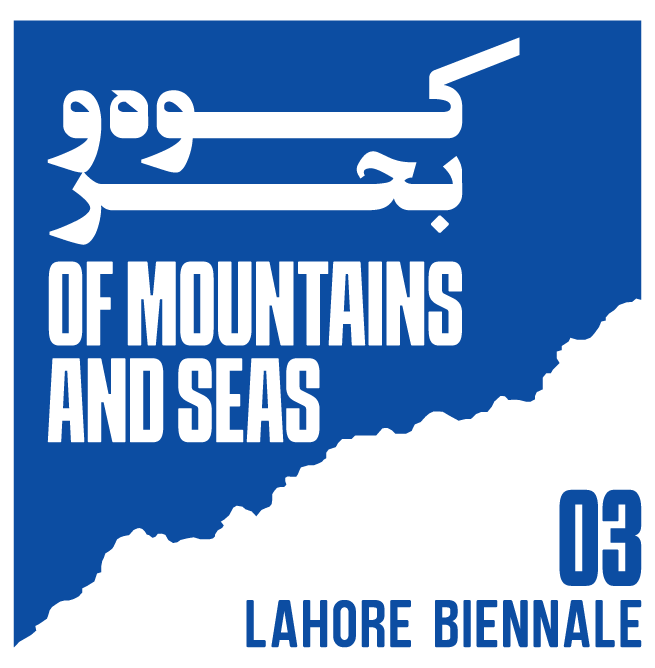In June 2022, a combination of torrential rains and melting glaciers led to the largest flood in Pakistan’s history. Then Minister of Climate Change announced to the world that a third of the country was inundated. Seemingly overnight, the country became the latest poster child for climate injustice. Despite contributing less than one percent of world carbon emissions, the country now ranks as one of the ten most vulnerable to the effects of climate crisis, posing in stark terms the inequity.
But the city, like the rest of the country, is more than the sum of the challenges that confront it. Both are dense with heritage that reaches back thousands of years, a testament to the millennia of human coexistence with the environment in South Asia, to the resilience, and the resourcefulness, of the people who have called it home. This is evidenced by several of the Biennale venues, such as Lahore Fort or, for the first time this edition, Shalimar Gardens. In addition to their beauty, these structures also offer evidence of alternative relations to nature. An example of this can be seen in the ingenious gravity- and pressure-driven system that originally supplied Shalimar’s lush and elaborate gardens and hundreds of fountains with flowing water. Though the Mughals did not operate with such concepts, their hydrology could be considered carbon-neutral.
The Biennale highlights the city’s heritage by putting it in dialogue with contemporary work, many of them new commissions, by sixty-one artists, from Pakistan and over thirty other countries. Many investigate or suggest the ways that the vernacular culture found in the architecture and craft traditions from the Global South suggests ways that history offers resources for imagining sustainable futures. In doing so, the Biennale not only highlights the rich culture of Lahore and Pakistan, its human side, but also suggests how societies across Global South, rather than rely on the actions of industrialised nations, can take agency and contribute to global conversations on climate futures by reconnecting with local and indigenous cultures, as resources. The Biennale, together with its concluding Climate Congress, thinks with artists, researchers, activists, and others of the rich cultural heritage of Asia and the Global South, and how the past can be more than folklore and tradition, but also knowledge that contributes to the necessary reimagining of the future, and people’s relationships to earth, air, water, and the multitude of life.
جون ۲۰۲۲ میں، مسلسل بارشوں اور پگھلتے گلیشیئرز کے ملاپ نے پاکستان کی تاریخ کے سب سے بڑے سیلاب کو جنم دیا۔ اُس وقت کی وزیر برائے موسمیاتی تبدیلی نے دنیا کے سامنے ملک پاکستان کے ایک تہائی حصہ زیر آب آنے کی خبر پیش نظر لائی ۔ بظاہر ایک رات میں ہی، ملک موسمیاتی ناانصافی کی تازہ ترین مثال بن گیا۔ عالمی کاربن انبعاث میں ایک فیصد سے بھی کم حصہ ڈالنے کے باوجود، پاکستان اب موسمیاتی بحران کے اثرات کے لحاظ سے دنیا کے دس سب سے زیادہ متاثرہ ممالک میں شامل ہے۔ یہ بات اس ناانصافی کی آکاسی کرتی ہے۔
لیکن لاہور، باقی تمام ملک کی مَثل، صرف ان آفات کا مجموعہ نہیں ہے ۔ یہ شہر، اور یہ ملک، ہزاروں سالوں پر محیط ورثے سے مالا مال ہیں، جو جنوبی ایشیا میں بشر اور ماحول کے درمیان ہزاروں سالہ بقائے باہمی، لوگوں کی ثابت قدمی اور وسائل سے بھرپور زندگی کا ثبوت ہیں۔ اس کا ثبوت بینالے کی کئی مقامات سے ملتا ہے، جیسے لاہور کا قلعہ یا اس ایڈیشن میں پہلی بار شامل ہونے والے شالامار باغات۔ ان کی خوبصورتی کے ساتھ ساتھ یہ ڈھانچے قدرت کے ساتھ متبادل تعلقات کا بھی ثبوت فراہم کرتے ہیں۔ ایک مثال شالامار باغات کے اصل میں موجود پیچیدہ اور جاذب نظر باغات اور سینکڑوں فواروں کو پانی فراہم کرنے والے، کشش ثقل اور دباؤ پر مبنی نظام سے دیکھی جا سکتی ہے۔ اگرچہ مغلوں نے اس طرح کے تصورات پر کام نہیں کیا، ان کی آبی سائنس کو کاربن سے پاک تصور کیا جا سکتا ہے۔
بینالے شہر کے ورثے کو معاصر کاموں کے ساتھ مکالمے میں رکھ کر اجاگر کرتا ہے، جن میں سے بہت سے نئے کمیشن ہیں، جو اکسٹھ فنکاروں نے پاکستان اور تیس سے زیادہ ممالک سے تیار کیے ہیں۔ ان میں سے کئی فنکار یہ تحقیق کرتے ہیں یا اس بات کی تجویز دیتے ہیں کہ گلوبل ساؤتھ کی فن تعمیر اور دستکاری کی روایات میں موجود مقامی ثقافت اس بات کی وضاحت کرتی ہے کہ کس طرح تاریخ پائیدار مستقبل کا تصور کرنے کے لیے وسائل فراہم کرتی ہے۔ ایسا کرنے میں، بینالے نہ صرف لاہور اور پاکستان کی ثقافتی دولت، اس کے انسانی پہلو کو اجاگر کرتا ہے، بلکہ یہ بھی تجویز کرتا ہے کہ کس طرح گلوبل ساؤتھ کے معاشرے، صنعتی ممالک کے اقدامات پر انحصار کیے بغیر، اپنے مقامی اور مقامی ثقافتوں کے ساتھ دوبارہ جڑ کر، عالمی موسمیاتی مستقبل پر مکالمات میں شرکت کر سکتے ہیں۔ بینالے، اپنے اختتامی موسمیاتی کانگریس کے ساتھ، فنکاروں، محققین، کارکنوں، اور دیگر کے ساتھ مل کر ایشیا اور گلوبل ساؤتھ کے ثقافتی ورثے پر غور کرتا ہے، اور اس بات پر روشنی ڈالتا ہے کہ ماضی صرف روایات اور قصے کہانیاں ہی نہیں بلکہ ایسا علم بھی ہے جو مستقبل کے لازمی ازسرنو تصور اور انسانوں کے زمین، ہوا، پانی، اور زندگی کی کثرت کے ساتھ تعلقات میں معاون ہو سکتا ہے۔

